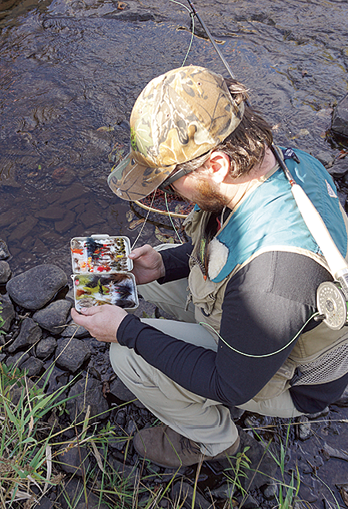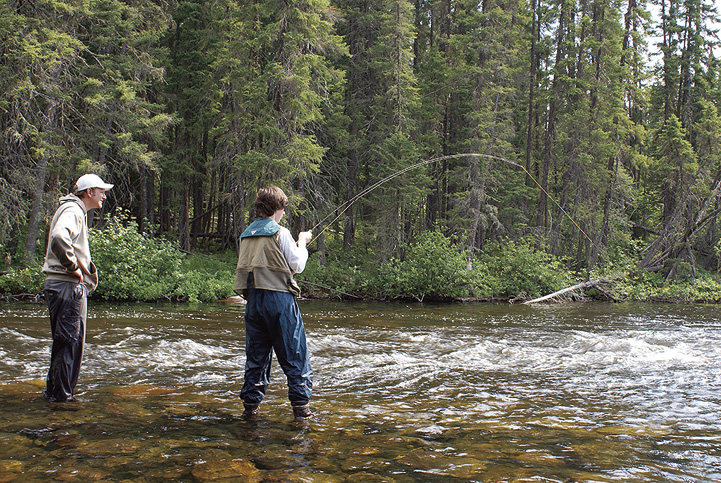A classic trout creek or river may not always be swift, clear, and pretty. However, a lot of them in northwest Ontario are, which is one of my favourite things about trout fishing. Some rivers feature “alligator water,” my name for slow waters choked with overhanging grass or weeds. Other trout rivers are swift and rollicking, with spring water entering, or areas of upwelling. All creeks and rivers have certain areas that hold more trout than others. Let’s break down where and how to fish small waters for trout.
Pools and Falls
The pools in a creek or small river hold deep water refuge for trout, as well as plentiful food and cover. You can rarely go wrong casting at the entrance and tail out of a pool. Any part of a pool can potentially hold trout, but where the current is flowing in or out is a natural place for fish to feed.
Falls are created by a break, or landform, that creates a change in elevation. Manmade weirs can also create falls. Some falls are high, but most are less than 6 feet. The falls oxygenates the water, which is something all trout like. Steelhead and other migratory salmonids will sit below a falls before they jump. Some falls are no fishing areas for this reason (check your local regulations). While the plunge pool of a falls is the natural fish holding habitat for trout, don’t ignore the top of a falls. There are often springs on top, and brook trout in particular will lay right on the edge of the fast water break, waiting for food that is swept by in the current.
Runs and Slow Water
Fishing the slower water of a river may not be your first instinct. However, all trout will use slow water areas depending on depth, cover, and water temperature. Trees, tall grass, shrubs, and branches that overhang slow water will provide the safety trout and migratory steelhead need. They also deliver the terrestrial bugs that brook trout in small water gorge on. I’ve found that slower water fish are nervous and will dart around if you don’t approach with stealth. Get low and wear dull colours when you are fishing small waters.
One of the hottest spots you can find on a small stream or river is a beaver dam, particularly the first few years of a new dam build. Beavers create reservoirs with the dams they build, and this makes a mini lake where there wasn’t one before. Pan-sized brook trout that have been living in small streams suddenly have room to move and grow. Steelhead that jumped over the dam in high water can get trapped behind them as well. That creates a rare chance to catch a very large fish on light tackle. As dams age, however, they tend to silt in and warm, making them less appealing to trout.
Tackling Streams
The nature of creeks and small rivers is tighter confines, and less water to cover. This will mean scaling back both your terminal tackle and downsizing your lures and flies. Light to ultra-light spinning gear will be the name of the game, with a rod length under 7 feet and light lines. Modern monofilament is thin, strong, and works well in tight quarters. You can use very light braid, but it is like a spiderweb, and I find it gets knotted up more easily.

The top lures for small streams will be downsized, but flashy. Tiny spinners are deadly in creeks as the spin of small blades seems to ring the dinner bell. The vibration of a spinner will also pull brookies out from undercut banks or fallen trees. A 1/4-ounce spinner like the Panther Martin, Mepps Black Fury, or Worden’s Rooster Tail will do the job in most small waters. Many spinner anglers add a tiny piece of worm to the hook for an additional attraction. Small spoons like the Williams, EGB Blinker, Little Cleo, Al’s Goldfish, or Krocodile are also great trout catchers, especially in pools, deep runs and beaver dams. Have a mix of sizes and weights up to about 3/8-ounce. Another very deadly lure family for small creeks are the various micro/ultra-light crankbaits that copy minnows, amphibians, and insects such as grasshoppers and cicadas.
Fly anglers can use a light set up and shorter rod with a floating line. I like a 5 or 6 weight fly rod on all but the smallest waters. On the coastal creeks and rivers I fish, the occasional lake run brook trout or steelhead will eat your fly and give you a fight to remember on a light rod. I usually carry one box of flies, with classic patterns like the Woolly Worm, Beadhead Soft Hackle, Royal Coachman, and March Brown. I’ll add a few Muddler Minnows, Clouser Minnows and a hopper pattern—and throw in a few basic nymph patterns for good measure. This is old school fly fishing, but it’s very fun. When you drop a hopper pattern on the top of the pool and have a brookie eat in the blink of an eye, you won’t care that there was little casting involved.
Bait
A worm on a #6 hook with a small split shot or two is always going to catch a trout. On coastal streams where salmonids and suckers spawn, brook trout and steelhead will grab a single egg or small spawn bag. Oddly enough, they eat salmon or trout eggs even when the spawning fish are gone. Drifting eggs under a small float with a #8 Octopus hook and minimal weight is the best way to fish eggs in small water.
Small stream trout fishing is both a great way to reconnect with your fishing roots and get away from the crowds.

